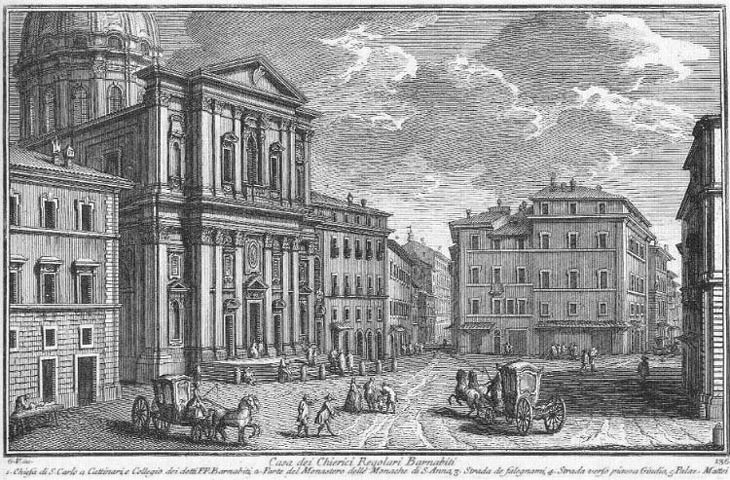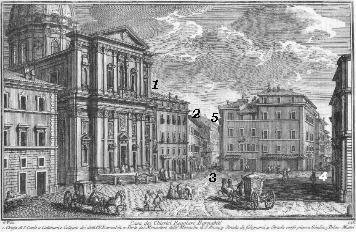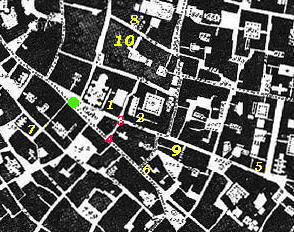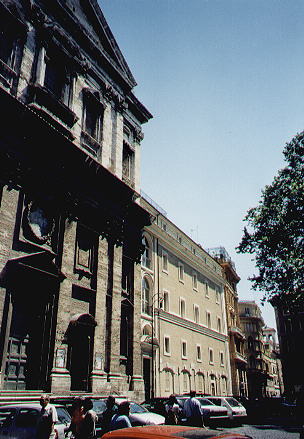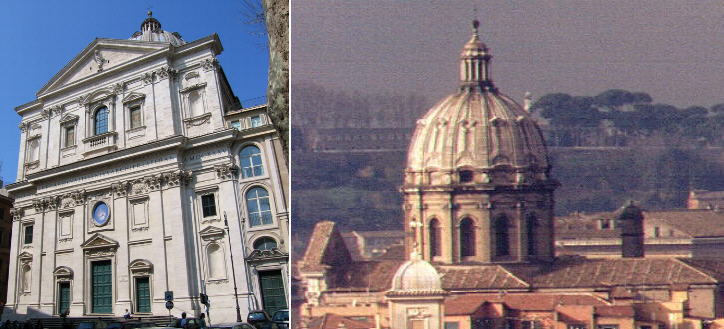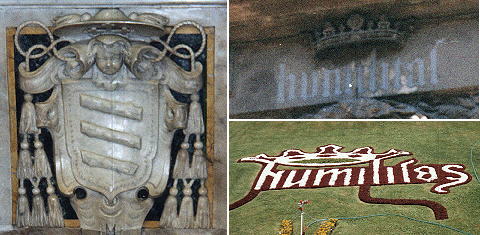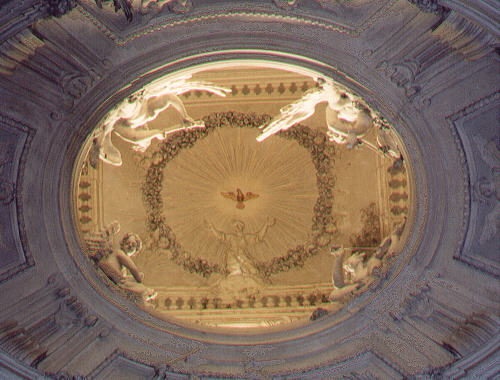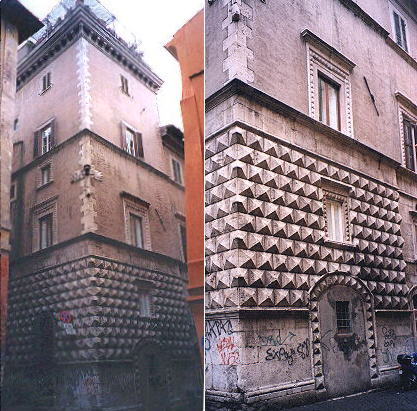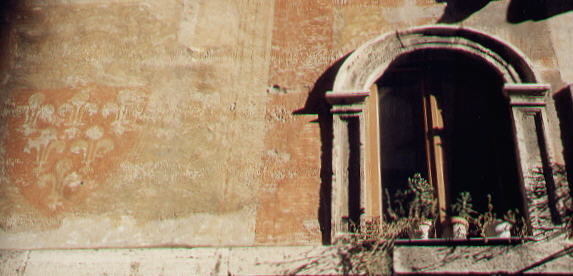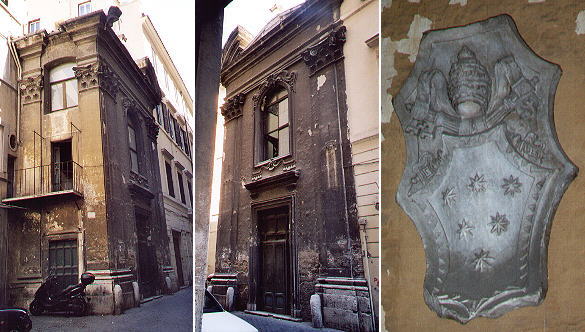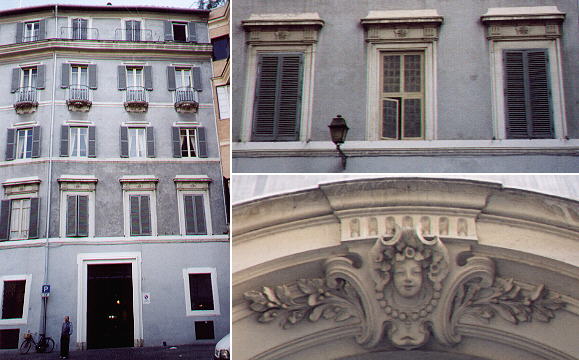  Chiesa di S. Carlo ai Catinari (Book 7) (Map C3) (Day 7) (View C8) (Rione Sant'Eustachio), (Rione Sant'Angelo) and (Rione Regola)
In this page:
The church is dedicated to S. Carlo Borromeo but the reference to
Catinari is due to the nearby many little shops which manufactured
and sold smallwares (catino=little basin). The view is taken from the green dot in the 1748 map below.
In the description below the plate Vasi made reference to: 1) S. Carlo de' Catinari; 2) Monastero delle Monache di S. Anna; 3) Strada dei falegnami (joiners/carpenters);
4) Street leading to Piazza Giudia; 5) Palazzo Mattei.
5) is shown in another page. The small map shows also 6) Palazzo Santacroce; 7) Casa di Alessandro Gancia; 8) Chiesa di Ges¨ Nazzareno o dei Santi Cosma e Damiano dei Barbieri; 9) Palazzo Boccapaduli; 10) Palazzo Cavallerini. The dotted line in the small map delineates
the borders between Rione Sant'Eustachio (top left quarter), Rione Pigna (top right quarter), Rione Regola (lower left quarter) and Rione Sant'Angelo (lower right quarter).
Although a large street (Via Arenula) divides the area of Campo di Fiori from the Ghetto still the view from the church towards Palazzo Mattei is pretty much the same, although Monastero di S. Anna was pulled down for the opening of Via Arenula in 1887. The small churches of S. Anna dei Falegnami and S. Elena dei Credenzieri, both in the vicinity of S. Carlo dei Catinari were pulled down too. The names of two existing streets (Via di S. Anna and Via di S. Elena) help in understanding where the churches were located.
The church has a fašade by G. B. Soria and one of the finest domes of Rome. The view taken from the terrace of the Monument to Victor Emmanuel shows that the dome is very close to the fašade (click here for a page on the Domes of Rome). This occurs because the church has a Greek cross shape, where all the arms have the same length. The interior is lavishly decorated with paintings and frescoes most of which represent San Carlo Borromeo whose motto Humilitas is written on the fašade. Below you see also a picture of the motto taken in the gardens of Palazzo Borromeo at Isola Bella (Lago Maggiore). The many coats of arms showing three clubs belong to Cardinal G. B. Leni who generously financed the erection of the building.
Antonio Gherardi (1644-1702) was a painter who acquired a great reputation for his frescoes in the ceiling
of S. Maria in Trivio. In 1695 he was commissioned the design and decoration of a chapel dedicated to S. Cecilia, saint patroness of the musicians.
While his large painting above the altar is rather academic, the architecture and the stuccoes decorating the vault of the chapel are
an excellent addition to the chapels designed by Gian Lorenzo Bernini a few years earlier.
The plate shows to the far right the street leading to Piazza Giudia. The second building in this street is the old Palazzo Santacroce (a larger Palazzo Santacroce is opposite S. Carlo ai Catinari), built at the end of the XVth century. The decoration, which reminds of Palazzo dei Diamanti in Ferrara, is unique in Rome. Close to the building is the Santacroce's church of S. Maria in Publicolis.
The street leading from S. Carlo dei Catinari to the little church of S. Salvatore in Campo is very narrow and the unaware passer-by may fail to notice what is left of the painted fašade of a Renaissance house. Here lived Alessandro Gancia who held several positions in the Papal court at the time of Paulus III (1534-50). He paid homage to his master by having painted on his house the coat of arms of Paulus III. Chiesa di Ges¨ Nazzareno o dei SS. Cosma e Damiano dei Barbieri and Palazzo Cavallerini
In 1560 the Barbers' guild was assigned a little church dedicated to SS. TrinitÓ. The barbers renamed
the church which was dedicated to SS. Cosma e Damiano (two Syrian saints of the IVth century, thought to be doctors).
In 1722-24 the church was almost completely rebuilt (the architect is unknown). It continued to belong to the Barbers' guild until 1888 when it was assigned to Confraternita (brotherhood) di Ges¨ Nazzareno and it was renamed.
It is in bad need of being restored. For a list of the churches belonging to a guild click here.
In 1555 Paulus IV issued a decree which forced the Jews living in the Papal States to move their residence
to a restricted area (ghetto) either in Rome or in Ancona. The area selected for the
Roman ghetto had a mixed population, both from a religious
and a social viewpoint. The Boccapaduli, a very ancient Roman family, left their palace located in the ghetto and bought a palace
immediately outside it in Via de' Falegnami. The palace was subsequently enlarged and what we see now is mainly
an XVIIIth century building.
Next plate in Book 7: S. Maria in Vallicella Next step in Day 7 itinerary: Palazzo Pio You have completed your tour of Rione Sant'Angelo! You have completed your tour of Rione Regola! Start your tour of Rione Sant'Eustachio; next step: S. Maria in Publicolis.
Go
to |
All images © 1999 - 2005 by Roberto Piperno. Write to romapip@quipo.it
